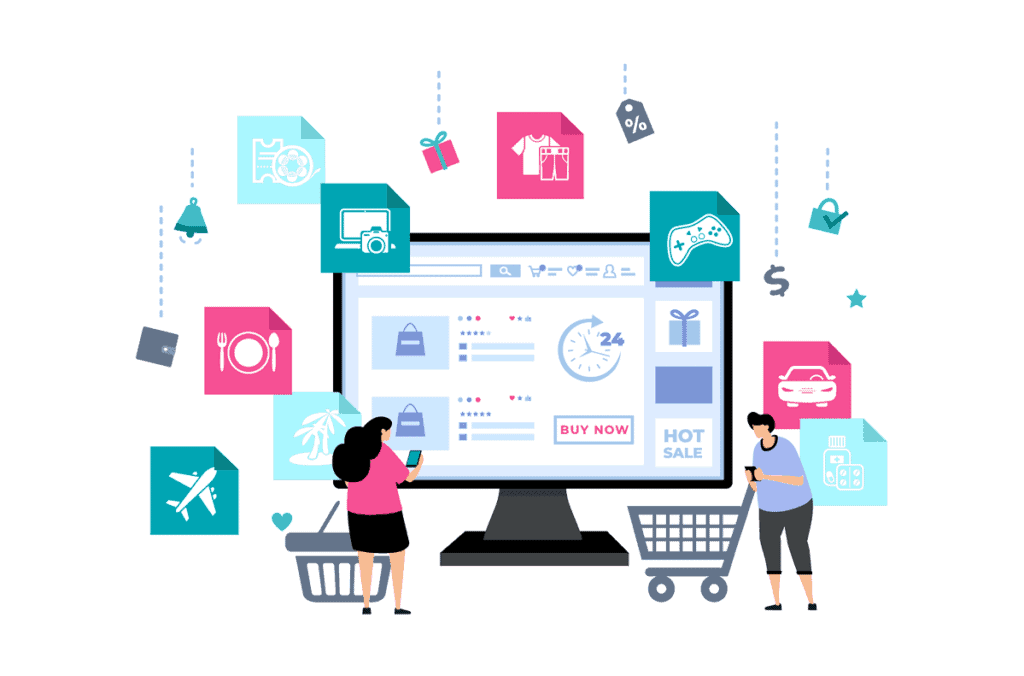Upselling and cross-selling are essential strategies for eCommerce businesses to increase revenue and enhance customer experience. It involves offering customers a higher-end or upgraded product than the one they originally intended to buy and recommending complementary products that can enhance the customer’s shopping experience.
Implementing these strategies in your WooCommerce store can lead to a significant increase in revenue by encouraging customers to make additional purchases. Using the right tactics, you can also improve customer satisfaction and loyalty by suggesting products that complement their original purchase, saving them time and providing a more convenient shopping experience.
In this article, we discuss various techniques and tools that you can use to effectively implement upselling and cross-selling strategies in your online store. Let’s dive in!
Understanding the Difference Between Upselling and Cross-Selling
Upselling and cross-selling are two distinct sales strategies used in eCommerce to encourage customers to purchase additional products. According to one survey, almost three-quarters of salespeople who upsell and cross-sell claim that it drives almost a third of their revenue. But while both strategies can increase revenue and improve customer satisfaction, they differ in their approach and purpose.
Upselling refers to the practice of persuading customers to purchase a higher-priced, upgraded, or premium version of the product they are considering. For example, if you sell knowledge online and a customer is considering buying one of your online courses on a particular subject, you may want to upsell your online course by recommending a more advanced course at a higher price point.
On the other hand, cross-selling involves suggesting complementary or related products that the customer may be interested in. For example, if a customer is purchasing an online course on a particular topic, you may want to recommend related courses, e-books, and study materials or even recommend signing up for a subscription or membership to enhance their learning experience.
Both strategies have numerous benefits for customers and store owners. Upselling can provide customers with a better product that meets their needs and satisfies them, while cross-selling can offer customers additional products that complement their original purchase, ultimately enhancing their overall learning experience. For store owners, these strategies can boost revenue, increase the average order value, and create customer loyalty by building trust and improving customer satisfaction.
Tips for Effective Upselling in Your WooCommerce Store


Upselling can be a powerful technique to increase sales and revenue in your WooCommerce store. However, it is essential to use it wisely and in a customer-friendly manner to avoid coming across as pushy or aggressive. Here are some tips for effective upselling in your WooCommerce store:
- Identify the right products and opportunities for upselling: Choose products that complement the customer’s original purchase, and offer upgrades that add value and meet their needs. Look for opportunities to upsell during the checkout process or on product pages, such as suggesting a better version of the product or add-ons that enhance the customer’s experience.
- Present upsells in a customer-friendly manner: Avoid being too pushy or aggressive in your approach. Instead, highlight the benefits of the upgraded product and how it meets the customer’s needs. Use language that is positive and persuasive, and offer a clear explanation of the additional cost.
But how might this look in practice? Take a restaurant ordering system run on WooCommerce as an example. You may want to enable customers to customize their meals with extra toppings or sides at an additional cost as an upsell. Alternatively, the system may also offer discounts or promotions for pairing a meal with a drink or dessert, encouraging customers to make additional purchases. By presenting these options in a customer-friendly manner, the restaurant can increase its revenue and provide a more personalized experience for the customer.
Implementing Cross-Selling Strategies in Your Online Store
Here are some tips for implementing cross-selling strategies in your online store:
- Choose complementary products for cross-selling: Look for products that are related to the customer’s original purchase and offer them as suggestions. For instance, if a customer is buying a camera, you could recommend lenses or a camera bag. You can also use data analytics to identify which products are frequently purchased together and use that information to make cross-selling suggestions.
- Utilize product bundling: Product bundling involves offering a group of products together at a discounted price. This can be an effective cross-selling strategy as customers are more likely to purchase a bundle of products than individual products. For example, a store that sells makeup products may offer a bundle that includes foundation, blush, and lipstick at a discounted price. This encourages customers to purchase the bundle and try out different products.
- Use a chained product plugin: Product bundle plugins enable you to create product bundles and suggest them to customers on the product page. For instance, if a customer is purchasing a camera, the plugin can suggest a bundle that includes a lens and a camera bag at a discounted price. This not only enhances the customer’s shopping experience but also increases the store’s revenue.
Leveraging Product Recommendations to Drive Upsells and Cross-Sells
Personalized product recommendations are another powerful tool for successful upselling and cross-selling in your WooCommerce store. Here’s why:
- Importance of personalized product recommendations: Personalized recommendations are tailored to the customer’s interests and preferences, making them more likely to purchase additional products. By presenting the right product recommendations, you can create a more personalized and engaging shopping experience that drives sales and revenue.
- How to use customer data and browsing history: To create targeted recommendations, use data analytics to analyze customer data, such as their browsing history, search queries, and purchase history. This data can provide valuable insights into the customer’s interests and preferences, allowing you to make relevant and personalized product recommendations.
For example, if a customer is browsing a particular category of products, you can recommend related products or complementary products that have been frequently purchased together. You can also use their purchase history to recommend similar products or upgrades that meet their needs.
You can do this through a variety of marketing techniques, including email marketing, paid advertising, banner ads, and more.
Optimizing Product Pages for Upselling and Cross-Selling
Product pages are a critical component of your WooCommerce store and can be optimized to encourage upsells and cross-sells. Here’s how:
- Display upsells and cross-sells effectively: Make sure to display upsells and cross-sells prominently on the product page, ideally above the fold. Use clear and concise language to explain the benefits of the upgraded or complementary products and provide a clear call-to-action to encourage the customer to add the product to their cart.
- High-quality images and product descriptions: The product images and descriptions are crucial in helping customers make informed purchasing decisions. Use high-quality images (use image upscaling if necessary) that showcase the product from different angles and provide accurate and detailed product descriptions. You can also use a gallery plugin, such as Modula or Envira Gallery, to display multiple images and provide a better visual experience for the customer.
- Tips for creating a smooth user experience: To encourage customers to consider additional purchases, create a smooth and intuitive user experience. Make sure the website is easy to navigate, with clear categories and product descriptions. Provide customer reviews and ratings to build trust and encourage social proof. You can also offer discounts or promotions for customers who purchase multiple items or bundles.
Using Email Marketing and Retargeting to Boost Upselling and Cross-Selling
Two of the most effective marketing techniques for upselling and cross-selling are email marketing and paid advertising. Let’s take a look at why they work so well and how you can maximize their impact.
Email marketing is a powerful tool for promoting upsells and cross-sells to your customers. By sending targeted and personalized emails to customers, you can showcase relevant product recommendations based on their purchase history, interests, and preferences.
This can help increase the likelihood of customers considering additional purchases, boosting your store’s revenue. Additionally, email marketing allows you to nurture customer relationships and build loyalty, encouraging repeat purchases and improving customer lifetime value.
If you’re not sure where to start, there are plenty of cross-selling and upselling email templates that you can find online to help inspire your own approach.
Retargeting ads are another way to drive customers back to your online store for additional purchases. By displaying personalized ads to customers who have previously visited your website or made a purchase, you can remind them of the products they were interested in and encourage them to return to your store.
Retargeting ads can be particularly effective for promoting upsells and cross-sells, as they can showcase complementary products or upgrades based on the customer’s previous browsing behavior or purchase history. Plus, stats show that retargeting ads increase the likelihood of conversion by around 70%, making it a worthwhile investment.
Tips for Creating Compelling and Personalized Promotional Emails and Ads:
- Segment your email list: Group your customers based on their preferences, purchase history, and behavior to send tailored emails that resonate with their interests.
- Use engaging subject lines: Write attention-grabbing subject lines that encourage customers to open your emails and explore your product recommendations.
- Personalize your message: Address your customers by name and include personalized product recommendations based on their browsing history and preferences.
- Showcase the benefits: Highlight the benefits of the recommended products or upgrades, including how they complement the customer’s original purchase or meet their specific needs.
- Include clear calls-to-action: Encourage customers to make additional purchases by providing clear and compelling calls-to-action in your emails and ads.
- Use high-quality visuals: Incorporate eye-catching images and visuals that showcase your recommended products, making them more appealing to your customers.
- Optimize for mobile devices: Ensure your promotional emails and ads are responsive and look great on all devices, as many customers will access them on their smartphones or tablets.
- Monitor and analyze results: Track the performance of your email marketing and retargeting campaigns, and use the insights gained to refine and improve your strategies for upselling and cross-selling.
Time to Maximize the Effectiveness of Your Upselling and Cross-Selling Strategies
Upselling and cross-selling are undoubtedly vital strategies for boosting revenue and enhancing customer satisfaction in your WooCommerce store. By implementing the techniques and tools outlined in this article, you can successfully encourage customers to make additional purchases while providing them with a more personalized and convenient shopping experience.
Don’t hesitate to incorporate these powerful sales strategies into your eCommerce business. By focusing on a customer-centric approach to upselling and cross-selling, you can not only increase revenue but also build trust and loyalty among your customers, ensuring long-term success for your WooCommerce store!



